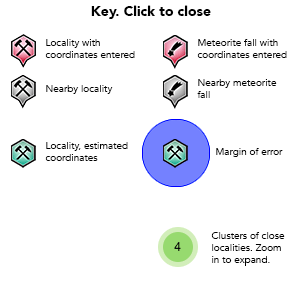Makareao quarry, Dunback, Waitaki District, Otago Region, South Island, New Zealand

| Latitude & Longitude (WGS84): | 45° 23' 43'' South , 170° 39' 26'' East |
|---|---|
| Latitude & Longitude (decimal): | -45.39536,170.65742 |
| GeoHash: | G#: pzcmg2hby |
| Locality type: | Quarry |
| Köppen climate type: | Cfb : Temperate oceanic climate |
Lime.
The quarry site contains an impressive multi storey Schmatolla kiln, and other historic structures, which are unfortunately not open to the public, due to modern quarrying activities.
Lime had been quarried in the area for agricultural purposes by D. Hutcheson in the 1860's, and R. Murray 1870's, with T. Falconer erecting the first small kiln. In 1896 the New Zealand government purchased land at the quarry site, and wanting to promote the use of lime by farmers, constructed a railway to the site, and opened a quarry and lime kiln in 1900.
The kiln proved inefficient, and a new gas fired kiln was built. A cutting collapsed during construction killing three workers. The enterprise was still losing money, so the government sold the site in 1909 to the Milburn Lime and Cement Company.
The manager of the company, Frank Oakden, visited Germany and purchased a Schmatolla kiln, from inventor Ernst Schmatolla. In 1913, a new coal fired kiln was built to handle smaller stone, then workers accommodation and a dining hall was erected in 1916, after a labour walk out. In 1917, a new carbonate of lime plant was erected for agricultural lime, and by 1918 the plants were producing yearly 7000 tonnes of burn't lime for cement works, and 3500 tonnes of lime for agriculture. In 1929, the company began supplying lime to the Burnside Cement Works near Dunedin, which continued until the cement works closed in 1988. The kilns were converted to electrical power in the early 1930's. The old kilns were decommissioned in 1942. With the old quarry exhausted, a new quarry was opened further up the hill above the kilns in 1950, with a new crushing plant at the site opened 1954.
In 1963 Milburn Lime and Cement Company amalgamated with New Zealand Cement , operating five lime works across New Zealand. This company was later taken over by Holcim. Operations at present are being conducted by Taylor's Lime, owned by a British Columbian (Canada) company.
The Schmatolla lime kiln presently sits next to the modern processing plant. Two old quarries remain just up the valley. Three buried pot kilns are up the hillside above the Schmatolla kiln, with a brick forge from the demolished engineering workshop, and winch shed with intact steam winch, and timber barrels for the cable. Concrete piers remain for the cableway from the old quarries to the plant, concrete foundations for the single mens quarters, and nearby a brick swimming pool.
No minerals currently recorded for this locality.
Regional Geology
This geological map and associated information on rock units at or nearby to the coordinates given for this locality is based on relatively small scale geological maps provided by various national Geological Surveys. This does not necessarily represent the complete geology at this locality but it gives a background for the region in which it is found.
Click on geological units on the map for more information. Click here to view full-screen map on Macrostrat.org
| Pleistocene 0.0117 - 2.588 Ma ID: 1308032 | Middle Quaternary alluvium and colluvium Age: Pleistocene (0.0117 - 2.588 Ma) Stratigraphic Name: Pakihi Supergroup Description: Weathered gravel, sand, silt and mud of alluvial and colluvial origin. Comments: Zealandia Megasequence Terrestrial and Shallow Marine Sedimentary Rocks (Neogene) Lithology: Gravel, sand, silt, mud Reference: Edbrooke, S.W., Heron, D.W., Forsyth, P.J., Jongens, R. (compilers). Geology Map of New Zealand 1:1 000 000. GNS Science Geological Map 2. [12] |
| Middle Pleistocene 0.126 - 0.781 Ma ID: 1368453 | OIS8+ (Middle Pleistocene) fan deposits Age: Pleistocene (0.126 - 0.781 Ma) Description: Moderately to highly weathered piedmont fan gravels with variable loess cover. Comments: Middle Pleistocene river deposits. Age based on geomorphic estimate Lithology: Major:: {gravel},Minor:: {sand, silt} Reference: Heron, D.W. . Geology Map of New Zealand 1:250 000. GNS Science Geological Map 1. [13] |
| Triassic - Permian 201.3 - 298.9 Ma ID: 3189657 | Paleozoic-Mesozoic crystalline metamorphic rocks Age: Phanerozoic (201.3 - 298.9 Ma) Stratigraphic Name: Haast Schist Comments: Caples Terrane Lithology: Metawacke; greenschist/almandine amphibolite grade metasedimentary/metavolcanic schist Reference: Chorlton, L.B. Generalized geology of the world: bedrock domains and major faults in GIS format: a small-scale world geology map with an extended geological attribute database. doi: 10.4095/223767. Geological Survey of Canada, Open File 5529. [154] |
Data and map coding provided by Macrostrat.org, used under Creative Commons Attribution 4.0 License
External Links
https://farm1.staticflickr.com/777/33262926121_983aa5b262_b.jpg (picture)
http://www.taylorslime.co.nz/
http://www.heritage.org.nz/the-list/details/4368



